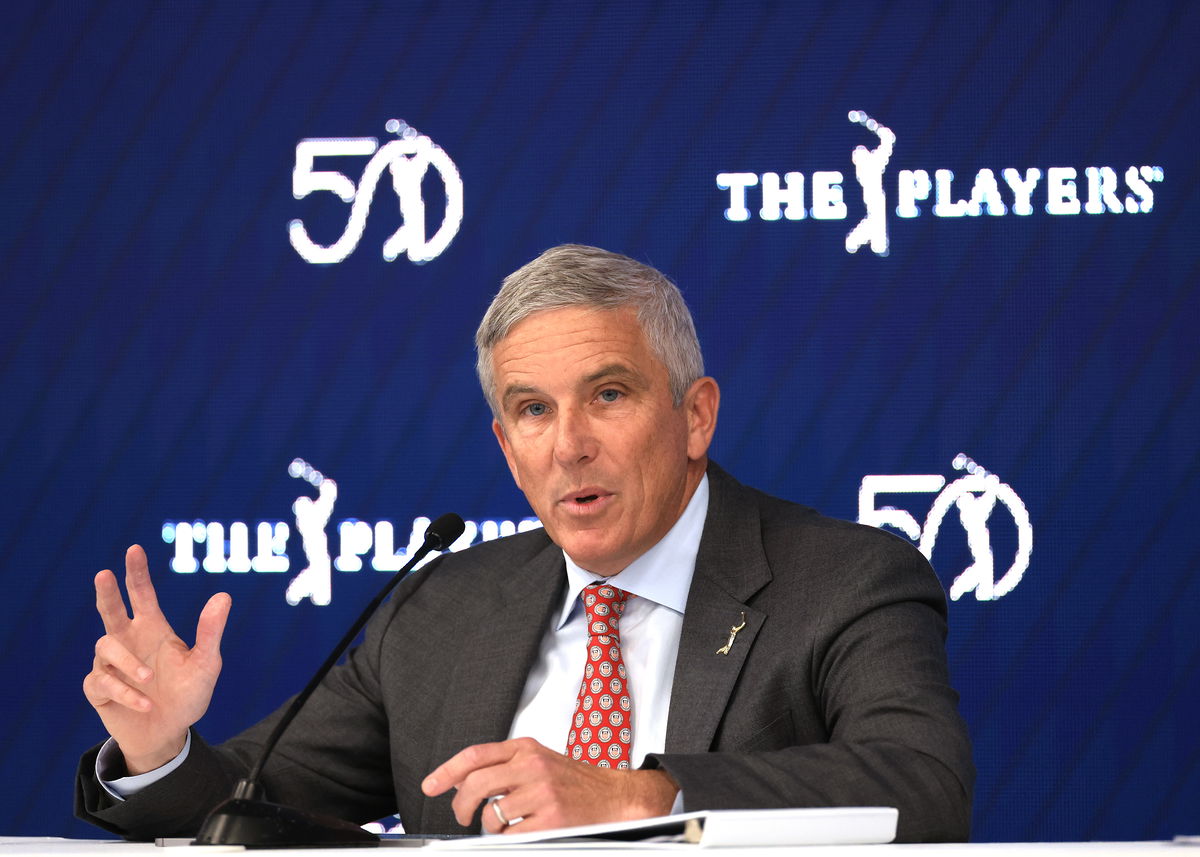
Getty
PONTE VEDRA BEACH, FLORIDA – MARCH 12: Jay Monahan of The United States the commissioner of the PGA TOUR speaks to the media during his media conference prior to THE PLAYERS Championship on the Stadium Course at TPC Sawgrass on March 12, 2024 in Ponte Vedra Beach, Florida. (Photo by David Cannon/Getty Images)

Getty
PONTE VEDRA BEACH, FLORIDA – MARCH 12: Jay Monahan of The United States the commissioner of the PGA TOUR speaks to the media during his media conference prior to THE PLAYERS Championship on the Stadium Course at TPC Sawgrass on March 12, 2024 in Ponte Vedra Beach, Florida. (Photo by David Cannon/Getty Images)
The most controversial rule change in modern golf isn’t about dress codes or slow play. It’s about the ball. Specifically, how far it flies. Beginning in 2028, new equipment rules will force elite players to use a “rolled-back” golf ball designed to fly 10 to 15 yards shorter. Recreational players will follow suit in 2030. The intent? Curb ever-increasing driving distances before the game’s most historic courses become obsolete.
Watch What’s Trending Now!
But how that decision came to be, and who shaped it, has come into sharper focus, thanks to a revealing exit interview by outgoing USGA President Fred Perpall. Speaking to GOLF.com in August 2025, Perpall acknowledged that PGA Tour Commissioner Jay Monahan and his inner circle were not just participants but drivers of the final compromise. “We are not overly motivated by the professional game or by what’s good for the manufacturers,” Perpall said, pushing back against critics who accused the USGA and R&A of caving to Tour pressure.
Still, he made it clear that all sides had a hand in shaping the final version. “We have come up with a solution that every one of those parties has had a seat at the table, and we have compromised with the PGA of America and the PGA Tour, who heavily drove this process.” That’s a telling admission. In 2023, Monahan had flatly rejected the USGA’s original proposal; a “bifurcation” plan that would’ve applied only to elite events. He wrote to players that the proposed rollback was “not warranted” and “not in the best interest of the game.” That rejection triggered a full rework of the policy.
ADVERTISEMENT
“The change will happen.”
Outgoing USGA president Fred Perpall reflects on his tenure, the USGA’s priorities and the golf world’s response to the ball rollback.https://t.co/u0qxodZzoX
— GOLF.com (@GOLF_com) August 3, 2025
Instead of limiting the rule to pros, the new version applies universally, eventually impacting all players, not just the Tour. The test conditions were softened too: the new swing speed benchmark is 125 mph, rather than something higher. Perpall positioned the final rule as a result of intense collaboration, with the Tour’s influence clearly stamped on key changes. “So, everyone’s done their job, and it’s now time for us to do our job,” Perpall said, defending the USGA’s ultimate authority to set the rules, even if others don’t like them.
The result is a rule that tries to thread the needle: protect course integrity, honor the “one game” ethos, and keep stakeholders from walking away. But the fingerprints of Monahan and Tour leadership are all over it. This carefully negotiated outcome hasn’t calmed the noise, and many pros are still furious, or deeply skeptical.
ADVERTISEMENT
Top Stories
LIV Golf Braces for Another Possible Exit in Wake of Brooks Koepka Departure

Rory McIlroy Makes Feelings Clear on Bryson DeChambeau’s PGA Tour Return: ‘Have Lost…’

Amanda Balionis Confirms New Relationship Ending Months of Rumors

Bryson DeChambeau Gives Reality Check to Phil Mickelson When Asked to Select His Mount Rushmore for Golf

After Brooks Koepka, Another Pro Cuts All Ties With LIV Golf & Publicly Backs PGA Tour

What the players are saying
Tour players haven’t held back. Keegan Bradley called rolling back the ball for amateurs “monstrous” and “stupid,” blasting the idea that casual golfers should be penalized when the game is thriving post-COVID. Rickie Fowler echoed the sentiment, warning it would “knock [golf] back when it’s in the best position it’s ever been in.”
ADVERTISEMENT
Others like Jon Rahm and Matt Fitzpatrick argued for fairness—whatever happens, it should affect everyone equally. “You have to go all in for everyone or not,” Fitzpatrick said. Meanwhile, Rory McIlroy and Tiger Woods have supported rollback, especially for pros. McIlroy wrote that the change “puts golf back on a path of sustainability” and could revive lost skills. Tiger, always in favor of bifurcation, stated, “If you play in a pro event… use a pro ball.” In short, the debate isn’t dying, it’s evolving. As 2028 approaches, the rule is set. But the players? They’re still playing their part.
ADVERTISEMENT
ADVERTISEMENT
ADVERTISEMENT

